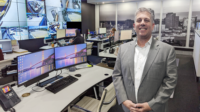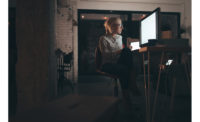The coronavirus pandemic metrics may fluctuate week-by-week and state-by-state, but many businesses and other public places that had been shuttered are now reopening in some mode — and that begs the question of how security integrators can help them establish safety through technology. One way is by measuring elevated skin temperatures of people entering a facility using thermal cameras. (See “Taking the Temperature of Thermal Cameras”) Another is by implementing video analytics to detect non-adherence to health safety practices and trigger audio reminders about distancing and other guidelines.
“Now that stay-at-home restrictions are being lifted, we want to help ensure that organizations are prepared for employees to safely return to work,” says Alan Stoddard, general manager and vice president, Verint Situational Intelligence Solutions, Melville, N.Y. “Confidence surrounding this process hinges on the employees’ perceptions of how well they will be protected while at work. Visible, simple and streamlined processes provide further proof that necessary measures are in place and employees, visitors and residents can be provided with peace of mind.”
One useful security technology that integrators can recommend is video analytics. When applied and used correctly with directives based on real-time surveillance of people’s behavior, they can create a positive encounter for people reentering social settings amidst the ongoing pandemic.
Repurposed & Reused
Many solutions now on the market are adaptations of existing technology, a feature that has enabled the surveillance industry to build solutions for reopening and bring them to market relatively quickly. Many manufacturers are focusing on repurposing cameras and analytics to help reduce the spread of COVID-19 and also work later for general security when the pandemic is over.
“Considering the recent pandemic and the imminent return to operations, there’s been no shortage of challenges, so our developers have been working on ways to use, repurpose and enhance our existing technology to serve new needs,” notes Jean-Pierre Picard, manager of product marketing at Montreal-based Genetec Inc.
“Many of the conversations with customers I am having start with the question, ‘What is your low-cost, high-impact occupancy management solution to get me through the pandemic?’,” says David Ewton, business development manager for Bosch Security and Safety Systems, Fairport, N.Y.
“For example, a single Bosch camera placed over the entries/exits of a building using on-board intelligent video analytics and a simple software tool will locally display the number of people in the building to assist with maintaining a safe occupancy. If the occupancy has hit a pre-determined threshold, the system can trigger a local public service announcement to inform people who may be waiting outside of the status of the building,” Ewton says.
Public Service Announcements
Audible announcements based on detection of occupancy levels and distancing protocols are also popular offerings from several video manufacturers. In fact, the Centers for Disease Control and Prevention (CDC) states, in its Resuming Business Toolkit – Worker Protections table, that businesses should “Use verbal announcements, signage, and visual cues to promote social distancing.”
David Ewton of Bosch Security and Safety Systems says, “Bosch Intelligent Video Analytics are built-in to Bosch IP cameras as standard today and are able to generate actions based on, for example, predetermined crowd levels or customers waiting outside in a line that is too long. These actions can include a public service announcement to keep people waiting informed and remind them of social distancing guidelines; local visualizations that display status; and digital notifications for employees.”
From its central command centers, intervention specialists at Interface Security Systems, a managed services provider with headquarters in Earth City, Mo., and Plano, Texas, can watch, listen to, and speak directly to any customer locations with Interface’s Automated Voice Down solutions. “This feature also provides the ability to make public announcements to remind customers and employees about proper social distancing and/or food-safety practices, for instance,” describes Brent Duncan, CRO of Interface. “The messages are scheduled throughout the day and play through our customer’s existing speaker system. Each message can be customized to touch directly upon the principal challenge of the day.”
Analytics in Action
One behavior that is increasingly being required in public places is the wearing of face masks — and there are analytics to detect adherence to that.
“The ability to detect individuals wearing masks is an important security issue, but the ability to detect people not wearing masks may now be even more important,” says Aluisio Figueiredo, CEO of ISS – Intelligent Security Systems, Woodbridge, N.J. “Our SecurOS Face Mask Detection is an intelligent video analytics module for the SecurOS Video Management Platform that detects the presence/absence of a protective mask on a person’s face...If the module detects the absence of a mask, the system will generate an alarm.”
Another key analytic is maintaining a specific occupancy level to adhere to social distancing guidelines.
“One of the challenges retailers and some other organizations face is managing their store’s occupancy level,” says Ryan Gregory, director of solutions & services, business development, Americas, Axis Communications, Chelmsford, Mass.
“Axis retailers can use analytics that allow for a user-defined occupancy threshold to help them manage occupancy levels with real-time data.”
Eagle Eye Networks, Austin, Texas, which offers line crossing, people counting, camera tampering, intrusion detection and loitering analytics on its Eagle Eye Cloud VMS, says that “line crossing and people counting have been particularly helpful to Eagle Eye customers during this time.”
Graham Staniforth, director of IT at United PF Partners LLC, also in Austin, says, “The Eagle Eye Cloud VMS gave us significant peace of mind during the pandemic. With the Eagle Eye Cloud VMS mobile application, we were able to seamlessly switch between 1,800 cameras at 115 United Planet Fitness locations with no disruption. The analytics in the application, such as people counting and intrusion detection, were also crucial for us during this time. We were able to see and receive alerts when people went into areas that were off-limits or when too many people were congregating in common areas, like the check-in counter. Getting these real-time alerts made it possible to ensure safe distances were being maintained, and that each of our locations were adhering to guidelines provided by the CDC.”
A third important analytic that is tied to occupancy levels looks at social distancing.
Do Analytics Solutions Really Help Keep People Safe?
In the realm of video analytics, a surge of solutions is coming to market to help end users make their businesses safe places to visit following the lifting of pandemic restrictions. But because many of these solutions were created for new applications, how does the security industry know if they will be effective in fostering a safe environment?
One line of reasoning is that it is too soon to understand the effectiveness of analytic-based reopening solutions.
“Quite honestly, it is too early to provide metrics on the effectiveness of any of the numerous back-to-work technology solutions coming to market, as many states are just now relaxing some of the social distancing and business closure restrictions that were implemented to combat the spread of COVID-19,” says William Brennan of Panasonic i-PRO Sensing Solutions, speaking in late May. “I am sure much research will be conducted on all the new measures being implemented so that we are better prepared when we are faced with a similar situation.”
Fabio Marti, of Security & Safety Things, agrees. “There are many different solutions being promoted during this time of uncertainty, with multiple approaches to aid businesses in reopening as safely and expediently as possible. In this new situation, relevant metrics still need to emerge and form,” he says.
Systems integrator Interface Systems has received direct feedback and compliments from customers on the effectiveness of the company’s video surveillance solutions and major retailers are already relying on its Virtual Guard service to maintain social distancing. “We expect others to do the same as they reopen,” says Brent Duncan of Interface.
Interface expects to soon use artificial intelligence (AI) to determine when a store, restaurant or other facility is too crowded. “In the restaurant space, it will also be able to be used to determine if employees are washing their hands properly as they conduct food preparation. We expect to leverage AI for a host of actionable data that otherwise doesn’t make sense for human beings to discover by simply watching video. The efficiencies are enormous and are taking video surveillance to an entirely new level,” Duncan says.
Interface isn’t alone in trusting that analytic-based solutions are indeed working for their intended purpose, despite not having definitive proof. While it cannot be proven that they reduce the spread of COVID-19, it’s clear that they work well in helping organizations adhere to health safety guidelines.
“[These solutions] can help organizations minimize the disruption these recommendations bring to their day-to-day activities, react more rapidly to problematic situations, and reduce potential contacts by digitizing traditional offline processes,” says Jean-Pierre Picard of Genetec. “Their impact on transmission rate has not been tested, but they were designed hand-in-hand with customers facing specific challenges.”
Effectiveness and results are questions Motorola Solutions will answer in conjunction with customers, says John Kedzierski at the company. “...These are applications of AI that are new. You have to work with your customers, do trial deployments, consider results of internal testing that we do, and which we take very seriously, to make sure that you meet and understand what the limitations are.”
“We think prevention is extremely important, so we focused our AI teams on using our smart cameras,” says John Kedzierski, senior vice president, video security and analytics, Motorola Solutions, Chicago. “We ran some experiments and asked, can those same cameras that run AI at the edge that classify objects they see inside the scene — can they also reliably calculate distance between people? We found they can...We were able to make calibration automatic, to make it as simple as possible where you basically just hang the camera, turn the analytic on and let it do its work.”
One way retailers can manage and reduce queue levels is by installing network audio solutions that include a network camera embedded with queue monitoring analytics and a network speaker, according to Axis Communications. “This provides retailers with accurate real-time information about where bottlenecks occur. When triggered by an event, the analytic can prompt a network speaker or audio bridge to play a pre-defined audio clip to remind customers to maintain safe distances or follow other instructions,” Gregory describes.
The need to enforce occupancy rules that adhere to physical distancing measures is critical, Genetec says, describing its new Occupancy Management Package. “This solution can measure the occupancy of a building and assist in managing this by displaying, and notifying employees, that limits are being reached,” Picard says.
Security & Safety Things, based in Munich, Germany, offers an IoT platform that enables integrators and end users to harness the growing computing power of security cameras for enterprise-wide operational intelligence from the deployment of apps that run directly on the security camera. “There are many apps available on our Application Store that help end users with COVID-19-related challenges,” says Fabio Marti, head of marketing at Security & Safety Things. “Some of these can detect social-distancing violations, ensure that employees or guests are complying with the usage of face masks or other PPE, count people to monitor capacity restrictions or detect if a crowd is forming either outside a store or inside in the register queue.”
One approach to pandemic solutions from Hikvision, City of Industry, Calif., includes both thermal and analytic technologies in one solution. It offers bi-spectrum thermal-optical cameras with analytics that detect elevated skin-surface temperature and absence of a face mask. Some of the cameras have a built-in speaker with automated voice alarms. There is also a dual-lens camera with analytics for people counting and density-regulation.
And finally, facial recognition often ties into business solutions for safe reopening.
“Our new i-PRO AI Camera Series runs advanced analytics at the edge to differentiate humans and vehicles with detailed metrics, along with privacy masking to help ensure privacy protection,” says William Brennan, president of Panasonic i-PRO Sensing Solutions, Rolling Meadows, Ill. “Our … FacePRO Facial Recognition solution can detect and identify individuals even when wearing face masks and other forms of PPE, ensuring that the face behind the mask can still be matched if registered.”
Eric Hess, senior director of product management at Seattle-based SAFR, says, “We developed and sell the SAFR Facial Recognition Platform that works with IP cameras, VMS, access control, and other physical security infrastructure to enhance situational awareness and deliver live analytics.
“In addition to the core detection, recognition, and analytics features of the SAFR Platform, we have added new features and enhanced existing capabilities that specifically address the challenges of businesses as they look to reopen,” he says.
If you think of an application or a particular problem, there is likely an analytics-based solution for it, including for hospitals, schools, transportation facilities, casinos, concert and sporting venues, and more.
“We’ve been communicating with our partners regularly,” Kedzierski says. “Everybody has the same challenges: How do I know if people are wearing face masks; how do I know if they’re social distancing; how do I know I’m managing occupancy well?
“This is such a unique thing; there is not an industry, a vertical market, that has not been impacted. Everybody is thinking about what that new normal is … and you’ll need to use technology to help you navigate that new normal.”







